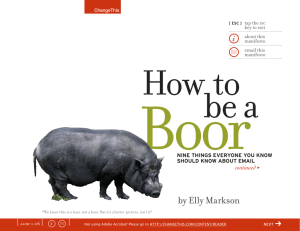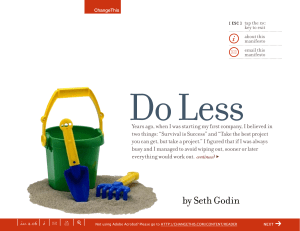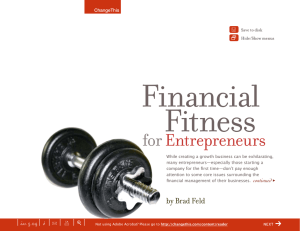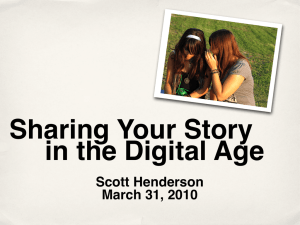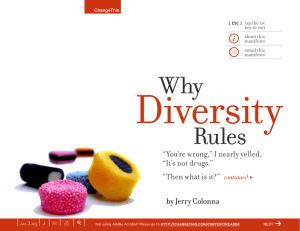START The Art of the
advertisement
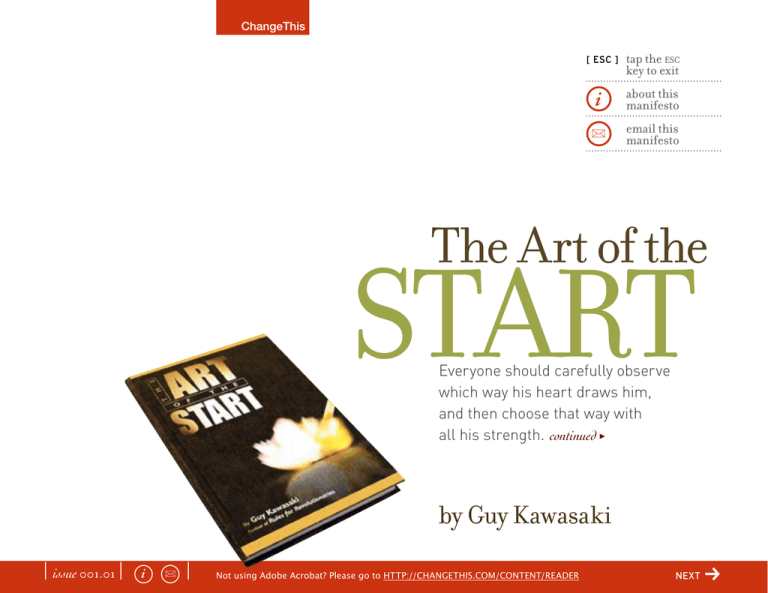
ChangeThis [ ESC ] tap the ESC key to exit i about this manifesto U email this manifesto The Art of the START Everyone should carefully observe which way his heart draws him, and then choose that way with all his strength. continued > by Guy Kawasaki | issue 001.01 | i U | Not using Adobe Acrobat? Please go to HTTP://CHANGETHIS.COM/CONTENT/READER NEXT f ChangeThis I use a top-ten list format for all my speeches, and I would love to begin this book with a top-ten list of the most important things an entrepreneur must accomplish. However, there aren’t ten—there are only five… GIST 1 2 This manifesto is an new book, The Art of the Start. To learn more, click here. | issue 001.01 | GO i U | MAKE MEANING. The best reason to start an organization is to make meaning—to create a product or service that makes the world a better place. So your first task is to decide how you can make meaning. MAKE MANTRA. Forget mission statements; theyʼre long, boring, and irrelevant. No one can ever remember them—much less implement them. Instead, take your meaning and make a mantra out of it. This will set your entire team on the right course. 3 GET GOING. Start creating and delivering your product or service. Think soldering 4 DEFINE YOUR BUSINESS MODEL. No matter what kind of organization youʼre 5 excerpt from Guyʼs [ GREAT IDEAS FOR STARTING THINGS ] irons, compilers, hammers, saws, and AutoCAD—whatever tools you use to build products and services. Donʼt focus on pitching, writing, and planning. starting, you have to figure out a way to make money. The greatest idea, technology, product, or service is short-lived without a sustainable business model. WEAVE A MAT (MILESTONES, ASSUMPTIONS, AND TASKS). The final step is to compile three lists: (a) major milestones you need to meet; (b) assumptions that are built into your business model; and (c) tasks you need to accomplish to create an organization. This will enforce discipline and keep your organization on track when all hell breaks loose—and all hell will break loose. h 2/34 f ChangeThis MAKE MEANING I have never thought of writing for reputation and honor. What I have in my heart must come out; that is the reason why I compose. — Ludwig van Beethoven Many books about entrepreneurship begin with a rigorous process of self-examination, asking you to determine if you are truly up to the task of starting an organization. Some typical examples are: • Can you work long hours at low wages? • Can you deal with rejection after rejection? • Can you handle the responsibility of dozens of employees? The truth is, it is impossible to answer questions like this in advance, and they ultimately serve no purpose. On the one hand, talk and bravado are cheap. Saying youʼre willing to do something doesnʼt mean that you will do it. On the other hand, realizing that you have doubt and trepidation doesnʼt mean you wonʼt build a great organization. How you answer these questions now has little predictive power regarding what youʼll actually do when you get caught up in a great idea. | issue 001.01 | i U | h 3/34 f ChangeThis 1 The truth is that no one really knows if he is an entrepreneur until he becomes one—and sometimes not even then. There really is only one question you should ask yourself before starting any new venture: Do I want to make meaning? Meaning is not about money, power, or prestige. Itʼs not even about creating a fun place to work. Among the meanings of “meaning” are to • • • • Make the world a better place. Increase the quality of life. Right a terrible wrong. Prevent the end of something good. Goals such as these are a tremendous advantage as you travel down the difficult path ahead. If you answer this question in the negative, you may still be successful, but it will be harder to become so because making meaning is the most powerful motivator there is. Itʼs taken me twenty years to come to this understanding. In 1983, when I started in the Macintosh Division of Apple Computer, beating IBM was our reason for existence. We wanted to send IBM back to the typewriter business holding its Selectric typewriter balls. In 1987, our reason for existence became beating Windows and Microsoft. We wanted to crush Microsoft and force Bill Gates to get a job flipping fish at the Pike Place Market. 1 | issue 001.01 | i U | If only defeating sexism were as simple as throwing in an occasional he/she, she, her, or hers. I use the masculine pronouns merely as a shortcut. Successful entrepreneurship is blind to gender. Donʼt look for sexism where none exists Guy has more to say in his new book, THE ART OF THE START. h 4/34 f ChangeThis In 2004, I am a managing director in an early-stage venture capital firm called Garage Technology Ventures. I want to enable people to create great products, build great companies, and change the world. The causation of great organizations is the desire to make meaning. Having that desire doesnʼt guarantee that youʼll succeed, but it does mean that if you fail, at least you failed doing something worthwhile. EXERCISE | COMPLETE THIS SENTENCE: If your organization never existed, the world would be worse off because MAKE MANTRA Close your eyes and think about how you will serve your customers. What kind of meaning do you see your organization making? Most people refer to this as the “Why” or mission statement of an organization. Crafting a mission statement is usually one of the first steps entrepreneurs undertake. Unfortunately, this process is usually a painful and frustrating experience that results in exceptional mediocrity. This is almost inevitable when a large number of people are commissioned to craft something designed to make an even larger number of people (employees, shareholders, customers, and partners) happy. | issue 001.01 | i U | h 5/34 f ChangeThis The fundamental shortcoming of most mission statements is that everyone expects them to be highfalutin and all-encompassing. The result is a long, boring, commonplace, and point2 less joke. In The Mission Statement Book, Jeffrey Abrams provides 301 examples of mission statements, which demonstrate that companies are all writing the same mediocre stuff. To wit, this is a partial list of the frequency with which mission statements in Abramsʼs sample contained the same words: • • • • • • Best ………………………… 94 Communities …………… 97 Customers ……………… 211 Excellence ………………… 77 Leader …………………… 106 3 Quality …………………… 169 Fortune (or Forbes, in my case) favors the bold, so Iʼll give you some advice that will make life easy for you: Postpone writing your mission statement. You can come up with it later when youʼre successful and have lots of time and money to waste. (If youʼre not successful, it wonʼt matter that you didnʼt develop one.) TIP: Click on an underlined 2 If you insist on creating a mission statement, go to http://artofthestart.com and click on the mission statement generator link http://unitedmedia.com/comics/dilbert/career/bin/ms2.cgi . This will take you to the Dilbert mission statement generator and save you thousands of dollars. 3 Jeffrey Abrams, The Mission Statement Book (Berkeley: Ten Speed Press, 1999), 25–26. hyperlink to visit that site. For more tips like this, visit ( i ) | issue 001.01 | GO i U | h 6/34 f ChangeThis Instead of a mission statement and all the baggage that comes with it, craft a mantra for your organization. The definition of mantra is: A sacred verbal formula repeated in prayer, meditation, or incantation, such as an invocation of a god, a magic spell, or a syllable or portion of scripture containing 4 mystical potentialities. What a great thing a mantra is! How many mission statements evoke such power and emotion? The beauty of a mantra is that everyone expects it to be short and sweet. (Arguably, the worldʼs shortest mantra is the single Hindi word Om.) You may never have to write your mantra down, publish it in your annual report, or print it on posters. Indeed, if you do have to “enforce” your mantra in these ways, itʼs not the right mantra. Following are five examples that illustrate the power of a good mantra: 5 • Authentic athletic performance (Nike). 6 • Fun family entertainment (Disney). 7 • Rewarding everyday moments (Starbucks). • Think (IBM). • Winning is everything (Vince Lombardiʼs Green Bay Packers) | issue 001.01 | i U | 4 The American Heritage Dictionary of the English Language, 4th ed., s.v. mantra. 5 Scott Bedbury, A New Brand World: 8 Principles for Achieving Brand Leadership in the 21st Century (New York: Viking, 2002), 51. 6 Ibid., 52. 7 Ibid., 53. For Guerrilla marketing advice, stay tuned to CHANGETHIS. h 7/34 f ChangeThis Compare the Starbucks mantra, “Rewarding everyday moments,” to the companyʼs mission statement, “Establish Starbucks as the premier purveyor of the finest coffee in the world while maintaining our uncompromising principles while we grow.” Which is more memorable? EXERCISE | In only the space provided, write your organizationʼs mantra: Imagine that someone asks your parents or your organizationʼs receptionist what you do. 8 Can it get any better than a three-word mantra such as “Authentic athletic performance”? A final thought on mantras: Donʼt confuse mantras and tag lines. A mantra is for your employees; itʼs a guideline for what they do in their jobs. A tag line is for your customers; itʼs a guideline for how to use your product or service. For example, Nikeʼs mantra is “Authentic athletic performance.” Its tag line is “Just do it.” 8 | issue 001.01 | i U | Actually, it could. Back in the early days, we toyed with “We take the FU out of funding” for Garageʼs mantra, but we rejected it because it was too long. :-) h 8/34 f ChangeThis EXERCISE The following chart contains the real ORGANIZATION REAL MISSION STATEMENT HYPOTHETICAL MANTRA Southwest Airlines “The mission of Southwest Airlines is Better than driving. mission statements of dedication to the highest quality of Customer Service delivered with a sense several organizations, of warmth, friendliness, individual pride, and hypothetical and Company Spirit.” mantras that I made up for them. Which Coca-Cola do you think is more powerful? Wendyʼs “The Coca-Cola Company exists to benefit and refresh everyone it touches.” “The mission of Wendyʼs is to deliver superior quality products and services for Refresh the world. Healthy fast food. our customers and communities through leadership innovation and partnerships.” Red Cross “To help people prevent, prepare for and Stop suffering. United States Air Force “To defend the United States and protect Kick butt in air and space. United Way (Hawaii) “The purpose of Aloha United Way is to Bring people together. respond to emergencies.” its interests through aerospace power.” provide leadership to bring people together to create a healthier, more compassionate community.” March of Dimes “March of Dimes researchers, volunteers, educators, outreach workers and advocates Save babies. work together to give all babies a fighting chance against the threats to their health: prematurity, birth defects, low birthweight.” | issue 001.01 | i U | h 9/34 f ChangeThis GET GOING The third step is not to fire up Word to write a business plan, launch PowerPoint to craft a pitch, or boot Excel to build a financial projection. Wrong, wrong, wrong! My goal in giving you this advice is not to reduce the sales of Microsoft Office—remember, Iʼm off the anti-Microsoft podium. Thereʼs a time for using all three applications, but itʼs not now. What you should do is (a) rein in your anal tendency to craft a document and (b) implement. This means building a prototype, writing software, launching your Web site, or offering your services. The hardest thing about getting started is getting started. (This is as true for a writer as it is for an entrepreneur.) Remember: No one ever achieved success by planning for gold. Don’t wait to develop the perfect product or service. Good enough is good enough. You should always be selling—not strategizing about selling. Donʼt test, test, test—thatʼs a game for big companies. Donʼt worry about being embarrassed. Donʼt wait to develop the perfect product or service. Good enough is good enough. There will be plenty of time for refinement later. Itʼs not how great you start—itʼs how great you end up. The enemy of activation is cogitation, and at this stage, cogitating the “strategic” issues of research and development is a problem. Questions like, “How far can we leap ahead?” “What if everyone doesnʼt like what we do?” and “Should we design for a target customer or make what we would want to use?” are beside the point when youʼre getting a new venture off the ground. | issue 001.01 | i U | Be first in line to get our newest manifestos. SIGN UP for our newsletter. h 10/34 f ChangeThis Instead, observe these key principles of getting going: • THINK BIG. Set your sights high and strive for something grand. If youʼre going to change the world, you canʼt do it with milquetoast and boring products or services. Shoot for doing things at least ten times better than the status quo. When Jeff Bezos started Amazon.com, he didnʼt build a bookstore with a paltry 25,000 more titles than the 250,000-title brick-and-mortar bookstores. He went to 3,000,000 titles in an online bookstore. • FIND A FEW SOULMATES. History loves the notion of the sole innovator: Thomas Edison (light bulb), Steve Jobs (Macintosh), Henry Ford (Model T), Anita Roddick (The Body Shop), Richard Branson (Virgin Airlines). History is wrong. Successful companies are started, and made successful, by at least two, and usually more, soulmates. After the fact, one person may come to be recognized as “the innovator,” but it always takes a team of good people to make any venture work. • POLARIZE PEOPLE. When you create a product or service that some people love, donʼt be surprised when others hate you. Your goal is to catalyze passion—pro or anti. Donʼt be offended if people take issue with what youʼve done; the only result that should offend (and scare) you is lack of interest. Car design is a good example of the love-versus-hate reaction; consider the bifurcation of peopleʼs reactions to cars such as the Mini Cooper, Infiniti Fx 45, and Toyota Scion xB. People are either devoted fans or relentless critics, and thatʼs good. • DESIGN DIFFERENT. Depending on what management fad is hot, you might be tempted to believe that there is only one ideal way to design products and services. This isnʼt true. There is no single best way. Here are four different and valid approaches—and I am sure there are more. | issue 001.01 | i U | h 11/34 f ChangeThis A. “I WANT ONE.” This is the best kind of market research—the customer and the designer are the same person. Therefore, the customerʼs voice can reach the designerʼs mind uncorrupted by corporate politics, reliance on the status quo, and market researchers. Example: Ferdinand Porsche said, “In the beginning I looked around and, not finding the automobile of my dreams, decided to build it myself.” B. 9 “MY EMPLOYER COULDN’T (OR WOULDN’T) DO IT.” Not as romantic as “I want one,” but this is a credible path. You already understand the customer base, competition, supply sources, and industry contacts because of your background. You still need to build the product or service and get customers, but many questions are already answered. For example, alumni of Unit 8200 of the Israeli Defense Forces went on to create companies such as Checkpoint after developing security software for the military. C. “WHAT THE HELL—IT’S POSSIBLE!” This theory isnʼt popular when times are tough, and microscopes are flourishing. At these times, the world has turned conservative and demands that every market be “proven.” Markets for curve-jumping, paradigm-shifting leaps are seldom proven in advance. For example, when Motorola invented cellular telephones, no one leaped to buy them. At that time, portable phone was an oxymoron because phones were always attached to places. There was no market for phones that customers could move. D. “THERE MUST BE A BETTER WAY.” The organization born of this philosophy is based on the idealistic notion that you can make the world a better place by doing something new. 9 | issue 001.01 | i U | Forbes FYI (Winter 2003): 21. h 12/34 f ChangeThis In many cases, the founders had backgrounds with no logical connection to the business. They simply got an idea and decided to do it. Example: eBay. Pierre Omidyar, the founder, wanted to implement a system for a “perfect market” for the sale of goods. (The story of his girlfriend wanting to sell Pez dispensers was an after-the-fact PR tale.) • USE PROTOTYPES AS MARKET RESEARCH. In the early days of an organization, there is high uncertainty about exactly what you should create and exactly what customers want. In these times, traditional market research is useless—there is no survey or focus group that can predict customer acceptance for a product or service that you may barely be able to describe. Would you buy a new computer with no software, no hard disk, and no color that simulates the real world— including a trash can? 10 The wisest course of action is to take your best shot with a prototype, immediately get it to market, and iterate quickly. If you wait for ideal circumstances in which you have all the information you need (which is impossible), the market will pass you by. The expected outcome of the “get going” principle is a first release of a product or service. Remember: it wonʼt be perfect. But donʼt revise your product to get prospective customers to love it. Instead, revise it because customers already love it. Let me put it in religious terms: Some people believe that if they change, God will love them. Others believe that since God loves them, they should change. The latter theory is the prototype to keep in mind for how to get going and keep going for startups. 10 This isnʼt how we positioned the first Macintosh, but itʼs a pretty accurate description of what we had. | issue 001.01 | i U | Be bold. Dream up your own manifesto and submit your idea HERE. h 13/34 f ChangeThis DEFINE YOUR BUSINESS MODEL You want to make meaning. Youʼve come up with a mantra. Youʼve started prototyping your product or service. The fourth step is to define a business model. To do this you need to answer two questions: • Who has your money in their pockets? • How are you going to get it into your pocket? These questions lack subtlety, but they are a useful way to consider the reality of starting an organization—even, and perhaps especially, not-for-profits, which have to fight for money just to stay alive. You canʼt change the world if youʼre dead, and when youʼre out of money youʼre dead. More elegantly stated, the first question involves defining your customer and the pain that he feels. The second question centers around creating a sales mechanism to ensure that your revenues exceed your costs. Here are some tips to help you develop your business model: • BE SPECIFIC. The more precisely you can describe your customer, the better. Many entrepreneurs are afraid of being “niched” to death and then not achieving ubiquity. However, most successful companies started off targeting specific markets and grew (often unexpectedly) to great size by addressing other segments. Few started off with grandiose goals and achieved them. • KEEP IT SIMPLE. If you canʼt describe your business model in ten words or less, you donʼt have a business model. You should use approximately ten words—and employ them wisely by using simple, everyday terminology. Avoid whatever business jargon is currently hip | issue 001.01 | i U | h 14/34 f ChangeThis (strategic, mission-critical, world-class, synergistic, first-mover, scalable, enterprise-class, etc.). Business language does not make a business model.11 Think of eBayʼs business model: It charges a listing fee plus a commission. End of story. • COPY SOMEBODY. Commerce has been around a long time, and by now clever people have pretty much invented every business model thatʼs possible. You can innovate in technology, markets, and customers, but inventing a new business model is a bad bet. Try to relate your business model to one thatʼs already successful and understood. You have plenty of other battles to fight. My final tip is that you ask women—and only women. My theory is that deep in the DNA of men is a “killer” gene. This gene expresses itself by making men want to kill people, animals, and plants. To a large degree, society has repressed this gene; however, starting an organization whose purpose is to kill another organization is still socially acceptable. Hence, asking a man about a business model is useless because every business model looks good to someone with the Y chromosome. For example, Sun Microsystems wants to kill Microsoft. When is the last time you bought a computer based on whom the manufacturer wanted to kill? 11 Inspired by Michael Shermer, Why People Believe Weird Things (New York: A.W.H. Freeman, 2002), 49. | issue 001.01 | i U | h 15/34 f ChangeThis Women, by contrast, donʼt have this killer gene. Thus, they are much better judges of the viability of a business model than men are. Donʼt agree with me? The book The Darwin Awards provides irrefutable proof of womenʼs greater common sense. These awards commemorate “those individuals who have removed themselves from the gene pool in a sublimely idiotic 12 fashion.” For example, in 1998 two construction workers fell to their demise after cutting a circular 13 hole in the floor while they were standing in the middle of the circle. The Darwin Awards contains nine chapters about the stupidity of men, and one chapter about the stupidity of women. I rest my case. EXERCISE STEP 1 Calculate your monthly costs to operate your organization. STEP 2 Calculate the gross profit of each unit of your product. STEP 3 Divide the results of Step 1 by the results of Step 2. STEP 4 Ask a few women if they think you have a chance of selling that many units. If they donʼt, you donʼt have a business model. 12 Wendy Northcutt, The Darwin Awards II (New York: Dutton, 2001), 2. 13 Ibid., 70. | issue 001.01 | i U | Guy has more to say in his newest book: THE ART OF THE START. h 16/34 f ChangeThis WEAVE A MAT (Milestones, Assumptions, and Tasks) One definition of mat is “a heavy woven net of rope or wire cable placed over a blasting site 14 to keep debris from scattering.” Preventing scattering is exactly what you need to do as the fifth, and final, step of launching your enterprise. In this case, MAT stands for milestones, 15 assumptions, and tasks. The purpose of compiling the MAT is to understand the scope of what youʼre undertaking, test assumptions quickly, and provide a method to find and fix the large flaws in your thinking. MILESTONES For most people a startup looks as if it must achieve a seemingly unlimited number of goals. However, out of these goals are some that stand head and shoulders above the others. These are the organizationʼs milestones—they mark significant progress along the road to success. There are seven milestones that every startup must focus on. If you miss any of them, your organization might die. 14 The American Heritage Dictionary of the English Language, 4th ed., s.v. mat. 15 Inspired by Rita Gunther McGrath and Ian C. MacMillan, “Discovery-Driven Planning,” Harvard Business Review (July–August 1995). | issue 001.01 | i U | h 17/34 f ChangeThis 1 Prove your concept. 2 Complete design specifications. 3 Finish a prototype. 4 Raise capital. 5 Ship a testable version to customers. 6 Ship the final version to customers. 7 Achieve break-even. There are seven milestones that every startup must focus on. If you miss any of them, your organization might die. These milestones apply to every kind of business. For example, a new school can prove its concept by seeing if two teachers, working as a team, using a new curriculum, can provide more individualized instruction and improve learning in a test classroom. With this proof of concept, the school can then complete the design of its curriculum, raise funds, roll out the prototype, and start teaching classes. | issue 001.01 | i U | h 18/34 f ChangeThis There are other tasks (weʼll come to them soon) that are also important to the survival of the organization, but none are as important as these milestones. The timing of these milestones will drive the timing of just about everything else you need to do, so spend 80 percent of your effort on them. Asking a man about a business model is useless because every business model looks good to someone with the Y-chromosome. EXERCISE MILESTONES Take down the corny framed mission statement in your lobby and replace it with a printout of target dates for completion of the seven milestones listed above. Make sure that employees and guests can read it. EXTRA CREDIT Repeat this procedure for every new product or service. Create a wall of fame to track the history of your organization. | issue 001.01 | i U | ChangeThis is giving you these manifestos free of charge. SEE THE REST OF THEM. h 19/34 f ChangeThis Assumptions Second, create a comprehensive list of the major assumptions that you are making about the business. These include factors such as: • • • • • • • • • • • • product or service performance metrics market size gross margin sales calls per salesperson conversion rate of prospects to customers length of sales cycle return on investment for the customer technical support calls per unit shipped payment cycle for receivables and payables compensation requirements prices of parts and supplies customer return on investment Continuously track these assumptions, and when they prove false, react to them quickly. Ideally, you can link these assumptions to one of the seven milestones discussed previously. Thus, as you reach a milestone, you can test an assumption. | issue 001.01 | i U | h 20/34 f ChangeThis Tasks Third, create another comprehensive list—this time of the major tasks that are necessary to design, manufacture, sell, ship, and support your product or service. These are necessary to build an organization, though they are not as critical as the seven milestones. They include: • • • • • renting office space finding key vendors setting up accounting and payroll systems filing legal documents purchasing insurance policies Continuously track…assumptions, and when they prove false, react to them quickly. The point of the list of tasks is to understand and appreciate the totality of what your organization has to accomplish, and to not let anything slip through the cracks in the early, often euphoric days. | issue 001.01 | i U | h 21/34 f ChangeThis Minichapter: The Art of Internal Entreprenuering Innovation often originates outside existing organizations, in part because successful organizations acquire a commitment to the status quo and a resistance to ideas that might change it. —Nathan Rosenberg A large number of aspiring entrepreneurs currently work for big companies. Like all entrepreneurs, they dream of creating innovative products or services and wonder if this can be done internally. The answer is yes. The purpose of this minichapter is to explain how. The “arts” that this book describes are equally appropriate for internal entrepreneurs—they, too, must innovate, position, pitch, write business plans, bootstrap, recruit, raise capital, partner, establish brands, make rain, and be mensches. But there are special recommendations that apply in this case. Ironically, many independent entrepreneurs envy the employees of big companies—they think that these lucky souls have humongous financial resources, large sales forces, fully equipped labs, scalable factories, and established brands, plus medical and dental benefits, at their disposal. How wonderful it would be, guys in garages muse, to invent a new product or service with the luxury of such an infrastructure already in place. | issue 001.01 | i U | Please donʼt be afraid; PASS THIS ALONG to as many people as you want! h 22/34 f ChangeThis Guess again. Creating a new product or service inside such a beast is not necessarily easier; the challenges are just different. I happen to have been part of a “best-case” scenario: the Macintosh Division of Apple. I can explain the success of this internal entrepreneurial effort in two words: Steve Jobs. His off-the-scale design talents, maniacal attention to detail, and reality-distorting personality (plus co-founder status) made Macintosh successful. Were it not for Steve Jobs, Macintosh would not exist—or it would have taken the form of an Apple II with a trash can. Anyone with guts, vision, and political savvy should be able to set up an entrepreneurial outpost in an established business. But if it takes a Steve Jobs to innovate within large companies, you are undoubtedly thinking, we might as well give up right now. While that kind of visionary is in short supply in any business, anyone with guts, vision, and political savvy should be able to set up an entrepreneurial outpost in an established business. I collaborated on this minichapter with Bill Meade, a close friend who helped Hewlett-Packard organize its substantial vault of intellectual property. We came up with this list of recommendations for internal entrepreneurs. | issue 001.01 | i U | h 23/34 f ChangeThis • PUT THE COMPANY FIRST. The internal entrepreneurʼs primary, if not sole, motivation should remain the betterment of the company. Internal entrepreneurship isnʼt about grabbing attention, building an empire, or setting up a way to catapult out of the company. When you have a good idea for a product or service, it will attract a large number of employees, from the bottom up. They will support you if youʼre doing it for the company, but not if itʼs for your personal gain. If you can attract a large number of rank-and-file supporters, you might not be totally dependent on what the “vice presidents” say. • KILL THE CASH COWS. Donʼt announce this widely, but your charter is often to create the product or service that would put an end to existing products or services. Still, itʼs better that itʼs you whoʼs killing your companyʼs cash cows than a competitor or two guys in a garage. Macintosh killed Apple II. Would it have been better for Apple if a competitor had created Macintosh? No way. This recommendation is another reason why itʼs so important that youʼve put the company first: What youʼre doing is bound to be controversial. But if you donʼt kill the cash cows, someone external will. • STAY UNDER THE RADAR. Two guys in a garage should try to get as much attention as they can. Awareness of their efforts makes it easier to raise money, establish partnerships, close sales, and recruit employees. However, the opposite holds true for internal entrepreneurs. You want to be left alone until either your project is too far along to ignore or the rest of the company realizes that itʼs needed. The higher you go in a company, the fewer people are going to understand what youʼre trying to do. This is because the higher you go, the more people want to maintain the status quo and protect their positions. | issue 001.01 | i U | h 24/34 f ChangeThis • FIND A GODFATHER. In many companies, there are godfather figures. These are people who have paid their dues and are safe from everyday petty politics. They are relatively untouchable and usually have the attention and respect of top management. Internal entrepreneurs should find a godfather to support their projects by providing advice, technical and marketing insights, and protection—if it comes to the point where you need protection. • GET A SEPARATE BUILDING. An internal entrepreneur, sitting in the main flow of a big company, will die by a thousand cuts as each department manager explains why this new project is a bad idea. “The new always looks so puny—so unpromising—next to the reality of the massive, ongoing business.”16 The Macintosh Division started in a building that was far enough away from the rest of Apple that it stayed out of the daily grind, but was close enough to obtain corporate resources. A separate building will keep your efforts under the radar and foster ésprit de corps among your merry band of pirates. The ideal distance from the corporate pukes is between one-quarter mile and two miles—that is, close enough to get to, but far enough to discourage overly frequent visits. • GIVE HOPE TO THE HOPEFUL. Inside every corporate cynic who thinks that “this company is too big to innovate” is an idealist who would like to see it happen. Good people in big companies are tired of being ignored, forgotten, humiliated, and forced into submission. They may be trampled, but they are not dead. When you show them that youʼre driving a stake in the heart of the status quo, you will attract support and resources. Then your goal is to advance these people from wanting to see innovation happen to helping you make it happen. 16 Peter F. Drucker, Innovation and Entrepreneurship: Practice and Principles (New York: Harper & Row, 1985), 162. | issue 001.01 | i U | NEXT ISSUE: Learn to write your own corporate weblog. h 25/34 f ChangeThis • ANTICIPATE, THEN JUMP ON, TECTONIC SHIFTS. Structural deformations in a company are a good thing for internal entrepreneurs. Whether caused by external factors such as changes in the marketplace or internal factors such as a new CEO, tectonic shifts signal changes and may create an opportunity for your efforts. Effective internal entrepreneurs anticipate these shifts and are ready to unveil new products or services when they occur: “Look what weʼve been working on.” By contrast, corporate pukes say, “Now I see the shift. If you give me permission, six months, and a team of analysts, I can come up with a new product strategy.” • BUILD ON WHAT EXISTS. The downside of trying to innovate within a big company is clear and well documented, but there are also benefits to doing so. Donʼt hesitate to utilize the existing infrastructure to make innovation easier—start by stealing, if you have to. Youʼll not only garner resources, but also make friends as other employees begin to feel as if they are part of your team. If you try to roll your own solutions (as an extreme example, building your own factory), youʼll only make enemies. The last thing a startup inside a big company needs is internal enemies—there will be enough enemies in the marketplace. • COLLECT AND SHARE DATA. The day will inevitably arrive when a bean counter or lawyer is suddenly going to take notice of you and question the reasons for your projectʼs existence. If youʼre lucky, this will happen later rather than sooner, but it will happen. Prepare for that day by: | issue 001.01 | i U | (1) collecting data about how much youʼve spent and how much youʼve accomplished and (2) then sharing it openly. In big companies, data suppresses antibodies, but it might be too late to get the data once the antibodies appear. h 26/34 f ChangeThis • LET THE VICE PRESIDENTS COME TO YOU. Quick question: Do you think that your first step should be to get your vice president to sign off on your project? It shouldnʼt be. This is one of the last steps. A vice president will “own” your idea and support it more if he “discovers” it and then approaches you about sponsoring it. You may have to ensure that a vice president “accidentally” makes that discovery when the time is right, but this is not the same as seeking permission to get started. • DISMANTLE WHEN DONE. The beauty of an internal entrepreneurial group is that it can rapidly develop new products and services. Unfortunately, the very cohesiveness that makes it so effective can lead to its downfall later if it remains separate (and usually aloof) from the rest of the organization. Its effectiveness declines further as its members come to believe that only they “know” what to do, and the entrepreneurial group creates its own, new bureaucracy.17 If the product or service is successful, consider dismantling the group and integrating it into the larger organization. Then create a new group to jump ahead again. • REBOOT YOUR BRAIN. Many internal entrepreneurs will find that the rest of this book prescribes actions that are contrary to what theyʼve experienced, learned, and maybe even taught in big companies. The reality is that starting something within an existing company requires adopting new patterns of behavior—essentially, rebooting your brain. The following table (next page) will prepare you for whatʼs to come: 17 Andrew Hargadon, How Breakthroughs Happen: The Surprising Truth About How Companies Innovate (Boston: Harvard Business School Press, 2003), 116–17. | issue 001.01 | i U | h 27/34 f ChangeThis TOPIC BIG COMPANY STARTUP Positioning Being all things to all people Finding a niche and dominating it Pitching Sixty slides, 120 minutes, and Ten slides, twenty minutes, Writing a Two hundred pages of extrapolation Twenty pages of wishful Bootstrapping Staying in a Hyatt Regency instead Staying with a college buddy Recruiting Corporate headhunters screening Sucking in people who “get it” Big Four track records careers for stock options Partnering Negotiating I-win/you-lose deals Finding a way to increase sales Branding Advertising during the SuperBowl Evangelizing in the trenches Rainmaking Spiffs for resellers and commissions Sucking up, down, and across Being a mensch Calling the legal department Helping people who canʼt help you Business Plan | issue 001.01 | i U | fourteen-point font from historical data of a Ritz Carlton candidates with Fortune 500 or that the press will like for sales reps Receive fresh manifestos twice a month. FREE NEWSLETTER. and thirty-point font thinking instead of a Motel Six and are willing to risk their by piggybacking on others h 28/34 f ChangeThis FAQ (FREQUENTLY AVOIDED QUESTIONS) Q. I ADMIT IT: I’M SCARED. I canʼt afford to quit my current job. Is this a sign that I donʼt have what it takes to succeed? Am I not truly committed? A. You should be scared. If you arenʼt scared, something is wrong with you. Your fears are not a sign that you donʼt have the right stuff. In the beginning, every entrepreneur is scared. Itʼs just that some deceive themselves about it, and others donʼt. You can reduce these fears by diving into the business and making a little progress every day. One day youʼll wake up and you wonʼt be afraid anymore—or at least youʼll have a whole new set of fears. No matter what, never admit that youʼre scared to other employees. A CEO can never have a bad day. But donʼt go overboard, either, and act as if you have no concerns, because then they will know youʼre scared stiff. Q. SHOULD I SHARE MY SECRET ideas with anybody other than my dog? A. The only thing worse than a paranoid entrepreneur is a paranoid entrepreneur who talks to his dog. There is much more to gain—feedback, connections, opened doors—by freely discussing your idea than there is to lose. If simply discussing your idea makes it indefensible, you donʼt have much of an idea in the first place. (See the FAQ section of Chapter 7, “The Art of Raising Capital,” for a detailed discussion of nondisclosure agreements.) Q. HOW FAR ALONG should I be before I start talking to people about what Iʼm doing? A. Start right away. By doing so youʼll be constantly mulling over your idea—as both a foreground and background task. The more people you talk to, the richer your thoughts will be. If itʼs just you staring at your navel, all youʼll see is lint building up. | issue 001.01 | i U | h 29/34 f ChangeThis Q. HOW DO YOU KNOW IF IT’S TIME TO GIVE UP rather than continuing to pursue a doomed venture? A. The old platitude is that good entrepreneurs never give up. This is fine for books and speeches, but not for the real world. If three close friends tell you to give up, you should listen. As the saying goes, when three people tell you youʼre drunk, you should take a cab home. Itʼs okay to fail as long as you try again. Q. I THINK THAT I HAVE A GREAT IDEA, but I donʼt have a business background. What should I do now? A. First, if all youʼve done is come up with a great idea—for example, “a new computer operating system thatʼs fast, elegant, and bug free”— but you canʼt implement it, then you have nothing. In this case, donʼt waste anyoneʼs time until youʼve found other people who can do the engineering. Assuming that you can implement, there are two kinds of people you can recruit. First, you can get a mentor. This would be an older person who is willing to coach you from time to time but never actually do any work. Second, you could get a business partner. This is someone whoʼs willing to work side by side with you—even on a part-time basis—whose skill set complements yours. Either kind of person can make a big difference in your business. Q. WHEN SHOULD I WORRY about looking like a real business, with business cards, letterhead, and an office? A. Make business cards and letterhead immediately. Spend a few bucks and get them designed by a professional or donʼt do them at all. Ensure that the smallest type size is twelve points. An office isnʼt necessary until customers are coming to see you, or you run out of space for the team. | issue 001.01 | i U | h 30/34 f ChangeThis Q. DO I NEED A WEB SITE? A. Yes, particularly if youʼre going to raise money, serve lots of customers, change the world in a big way, and achieve liquidity. Customers, partners, and investors will look for your Web site from the very start. RECOMMENDED READING Christensen, Clayton. The Innovatorʼs Dilemma: When New Technologies Cause Great Films to Fail. New York: HarperBusiness, 1997. Drucker, Peter F. Innovation and Entrepreneurship: Practice and Principles. New York: Harper & Row, 1985. Hargadon, Andrew. How Breakthroughs Happen: The Surprising Truth About How Companies Innovate. Boston: Harvard Business School Press, 2003. Kuhn, Thomas. The Structure of Scientific Revolutions. Chicago: University of Chicago Press, 1962. Shekerjian, Denise. Uncommon Genius: How Great Ideas Are Born. New York: Penguin Books, 1990. Ueland, Brenda. If You Want to Write. St. Paul: Graywolf Press, 1987. Utterback, James M. Mastering the Dynamics of Innovation: How Companies Can Seize Opportunities in the Face of Technological Change. Boston: Harvard Business School Press, 1994. | issue 001.01 | i U | This manifesto is powered by ChangeThis. VIEW OUR ENTIRE MANIFESTO COLLECTION. h 31/34 f ChangeThis info ABOUT THIS AUTHOR Guy Kawasaki is CEO of http://garage.com, a Silicon Valley based firm that assists high-technology startups find startup capital using the Internet. Prior to this position, Kawasaki was an Apple Fellow at Apple Computer, Inc. A noted columnist (Forbes), speaker, and founder of various personal computer companies, Kawasaki was one of the individuals responsible for the success of the Macintosh com- puter. Kawasaki is the author of seven books: The Macintosh Way, Database 101, The Computer Curmudgeon, How to Drive Your Competition Crazy, Hindsights, and Selling the Dream. His most recent book is called Rules for Revolutionaries, published in January. 1999. DOWNLOAD THIS BUY THE BOOK This manifesto is available from http://changethis.com/1.ArtOfTheStart For more details or SEND THIS to buy a copy of Guy Click here to pass along a copy of this manifesto to others. Kawasakiʼs book, http://changethis.com/1.ArtOfTheStart/email The Art of the Start, click here. U SUBSCRIBE GO Learn about our latest manifestos as soon as they are available. Sign up for our free newsletter and be notified by email. http://changethis.com/subscribe GO z | issue 001.01 | i U | LAST PAGE READ | MORE f h 32/34 f ChangeThis info WHAT YOU CAN DO You are given the unlimited right to print this manifesto and to distribute it electronically (via email, your website, or any other means). You can print out pages and put them in your favorite coffee shopʼs windows or your doctorʼs waiting room. You can transcribe the authorʼs words onto the side- walk, or you can hand out copies to everyone you meet. You may not alter this manifesto in any way, though, and you may not charge for it. NAVIGATION & USER TIPS Move around this manifesto by using your keyboard arrow keys or click on the right arrow ( f ) for the next page and the left arrow ( h ). To send this by email, just click on U . KEYBOARD SHORTCUTS PC MAC Zoom in (Larger view) [ CTL ] [ + ] [ Full screen/Normal screen view [ CTL ] [ L ] Zoom out #] [#] [#] [ CTL ] [ - ] [+] [-] [L] BORN ON DATE This document was created on 13 August 2004 and is based on the best information available at that time. To check for updates, please click here to visit: http://www.changethis.com/1.ArtOfTheStart. z | issue 001.01 | i U | LAST PAGE READ | MORE f h 33/34 f ChangeThis info COPYRIGHT INFO The copyright in this work belongs to the author, who is solely responsible for the content. Please direct content feedback or permissions questions to the author: http://garage.com This work is licensed under the Creative Commons Attribution-NonCommercial-NoDerivs License. SOME RIGHTS RESERVED cc creative commons To view a copy of this license, visit http://creativecommons.org/licenses/by-nc-nd/2.0/ or send a letter to Creative Commons, 559 Nathan Abbott Way, Stanford, California 94305, USA. ABOUT CHANGETHIS ChangeThis is a vehicle, not a publisher. We make it easy for big ideas to spread. While the authors we work with are responsible for their own work, they donʼt necessarily agree with everything available in ChangeThis format. But you knew that already. z | issue 001.01 | i U | LAST PAGE READ h 34/34
